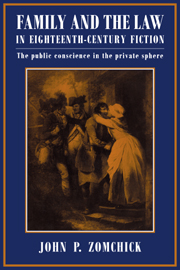Book contents
- Frontmatter
- Contents
- Preface
- Acknowledgments
- 1 Introduction
- 2 Roxana's contractual affiliations
- 3 Clarissa Harlowe: caught in the contract
- 4 Tame spirits, brave fellows, and the web of law: Robert Lovelace's legalistic conscience
- 5 Roderick Random: suited by the law
- 6 Shadows of the prison house or shade of the family tree: Amelia's public and private worlds
- 7 The embattled middle: longing for authority in The Vicar of Wakefield
- 8 Caleb Williams: negating the romance of the public conscience
- Bibliography
- Index
- Frontmatter
- Contents
- Preface
- Acknowledgments
- 1 Introduction
- 2 Roxana's contractual affiliations
- 3 Clarissa Harlowe: caught in the contract
- 4 Tame spirits, brave fellows, and the web of law: Robert Lovelace's legalistic conscience
- 5 Roderick Random: suited by the law
- 6 Shadows of the prison house or shade of the family tree: Amelia's public and private worlds
- 7 The embattled middle: longing for authority in The Vicar of Wakefield
- 8 Caleb Williams: negating the romance of the public conscience
- Bibliography
- Index
Summary
In the following pages a familiar figure emerges, taking shape against the background of society's laws. I have named this figure the “juridical subject” in order to emphasize that the figure owes its coherence to a system of legal beliefs, principles, and practices, which attain frequent and clear visibility both in the society and the narratives of eighteenthcentury England. Under a different emphasis the figure might be named the “liberal subject,” as in a recent study by D. A. Miller, or the “subject of Providence,” as in the work of Martin Battestin. The proliferation of labels suggests less a historical uncertainty or critical confusion than it does a profusion of social roles and critical methods for describing them. In current critical parlance, it attests to the recognition of fragmented subjectivity as the product of modern culture. In other words, the individual – whether ideological mirage or concrete person – is rarely all of a piece. Awareness of this fragmentation, both then and now, produces the need to create a design for living. In my readings of the following eighteenth-century novels I will argue that the law provides the matrix for one such design.
Law, of course, is new neither to eighteenth-century society nor to literature. Kathy Eden has demonstrated the influence of “the methods and procedures of the law” on Aristotelian literary theory from its origins through the Renaissance. Hayden White has suggested “that narrative in general, from the folktale to the novel, from the annals to the fully realized ‘history,’ has to do with the topics of law, legality, legitimacy, or, more generally, authority.”
- Type
- Chapter
- Information
- Family and the Law in Eighteenth-Century FictionThe Public Conscience in the Private Sphere, pp. xi - xviiPublisher: Cambridge University PressPrint publication year: 1993

